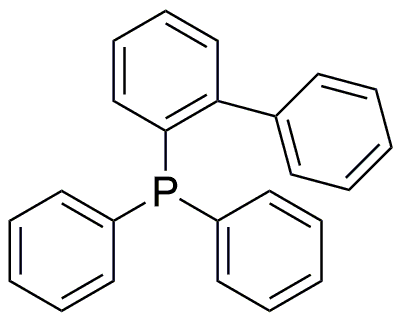2-(Diphenylphosphino)biphenyl is widely utilized in research focused on:
- Catalysis: This compound serves as a highly effective ligand in various catalytic processes, particularly in palladium-catalyzed cross-coupling reactions. Its ability to stabilize metal complexes enhances reaction efficiency, making it invaluable in organic synthesis.
- Pharmaceutical Development: In medicinal chemistry, it plays a crucial role in the design of new drugs. Its unique structure allows for the development of compounds with improved bioactivity and selectivity, which is essential for creating effective pharmaceuticals.
- Material Science: The compound is used in the synthesis of advanced materials, such as polymers and nanomaterials. Its properties contribute to the development of materials with enhanced electrical and thermal conductivity, beneficial for electronics and energy applications.
- Research in Organometallic Chemistry: It is a key component in the study of organometallic compounds, facilitating the understanding of metal-ligand interactions. This knowledge is crucial for developing new catalysts and materials.
- Environmental Applications: The compound is explored for its potential in environmental remediation processes. Its ability to bind with heavy metals can aid in the development of methods to remove pollutants from water and soil.
General Information
Properties
Safety and Regulations
Applications
2-(Diphenylphosphino)biphenyl is widely utilized in research focused on:
- Catalysis: This compound serves as a highly effective ligand in various catalytic processes, particularly in palladium-catalyzed cross-coupling reactions. Its ability to stabilize metal complexes enhances reaction efficiency, making it invaluable in organic synthesis.
- Pharmaceutical Development: In medicinal chemistry, it plays a crucial role in the design of new drugs. Its unique structure allows for the development of compounds with improved bioactivity and selectivity, which is essential for creating effective pharmaceuticals.
- Material Science: The compound is used in the synthesis of advanced materials, such as polymers and nanomaterials. Its properties contribute to the development of materials with enhanced electrical and thermal conductivity, beneficial for electronics and energy applications.
- Research in Organometallic Chemistry: It is a key component in the study of organometallic compounds, facilitating the understanding of metal-ligand interactions. This knowledge is crucial for developing new catalysts and materials.
- Environmental Applications: The compound is explored for its potential in environmental remediation processes. Its ability to bind with heavy metals can aid in the development of methods to remove pollutants from water and soil.
Documents
Safety Data Sheets (SDS)
The SDS provides comprehensive safety information on handling, storage, and disposal of the product.
Product Specification (PS)
The PS provides a comprehensive breakdown of the product’s properties, including chemical composition, physical state, purity, and storage requirements. It also details acceptable quality ranges and the product's intended applications.
Certificates of Analysis (COA)
Search for Certificates of Analysis (COA) by entering the products Lot Number. Lot and Batch Numbers can be found on a product’s label following the words ‘Lot’ or ‘Batch’.
Número de catálogo
Número de lote/lote
Certificates Of Origin (COO)
This COO confirms the country where the product was manufactured, and also details the materials and components used in it and whether it is derived from natural, synthetic, or other specific sources. This certificate may be required for customs, trade, and regulatory compliance.
Número de catálogo
Número de lote/lote
Safety Data Sheets (SDS)
The SDS provides comprehensive safety information on handling, storage, and disposal of the product.
DownloadProduct Specification (PS)
The PS provides a comprehensive breakdown of the product’s properties, including chemical composition, physical state, purity, and storage requirements. It also details acceptable quality ranges and the product's intended applications.
DownloadCertificates of Analysis (COA)
Search for Certificates of Analysis (COA) by entering the products Lot Number. Lot and Batch Numbers can be found on a product’s label following the words ‘Lot’ or ‘Batch’.
Número de catálogo
Número de lote/lote
Certificates Of Origin (COO)
This COO confirms the country where the product was manufactured, and also details the materials and components used in it and whether it is derived from natural, synthetic, or other specific sources. This certificate may be required for customs, trade, and regulatory compliance.


